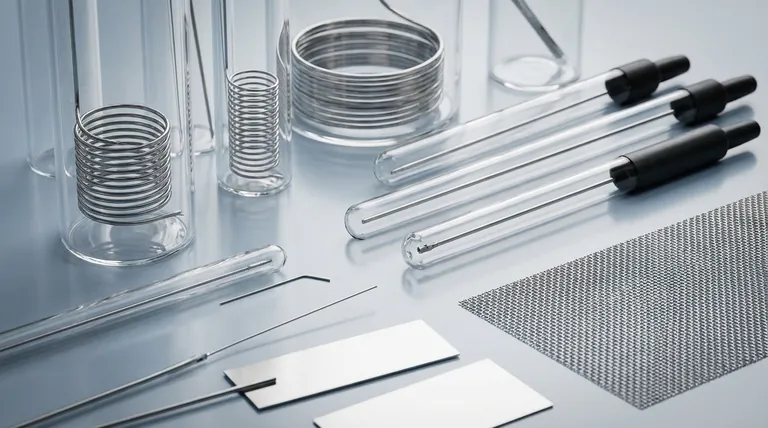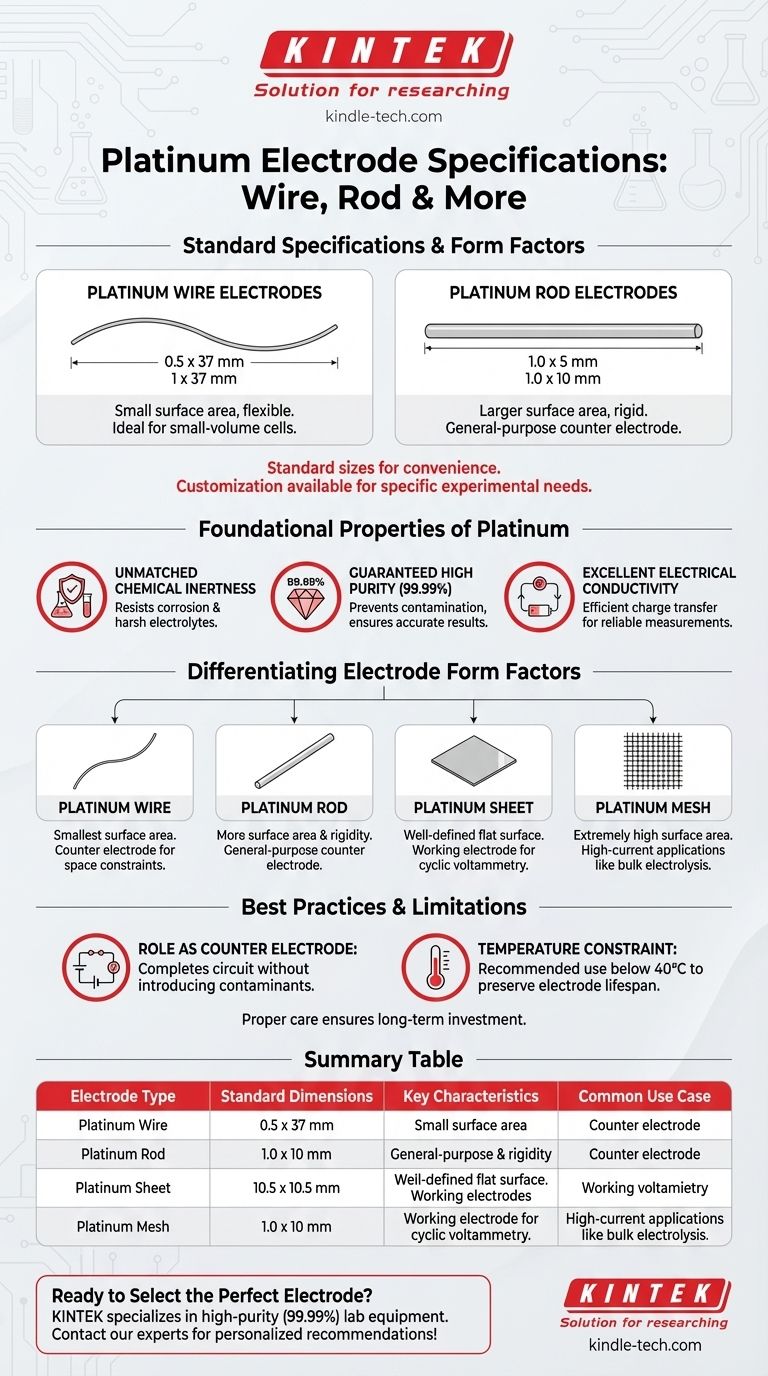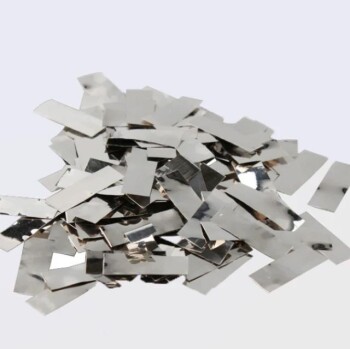The standard specifications for platinum wire electrodes are typically 0.5 x 37 mm and 1 x 37 mm. For platinum rod electrodes, the standard sizes are 1.0 x 5 mm and 1.0 x 10 mm, though customization for specific experimental needs is common.
While standard dimensions exist for convenience, the more critical decision is selecting the right electrode form factor—wire, rod, sheet, or mesh—based on the specific surface area and current density requirements of your electrochemical experiment.

The Foundational Properties of Platinum Electrodes
To understand the specifications, we must first understand why platinum is the material of choice for high-performance electrodes. Its value is rooted in a combination of unique physical and chemical properties.
### Unmatched Chemical Inertness
Platinum is a precious metal renowned for its stability. It resists corrosion and will not react even in harsh electrolytes, such as strong acids and alkalis, ensuring that the electrode itself does not interfere with your experiment.
### Guaranteed High Purity
Standard platinum electrodes are manufactured with a purity of 99.99%. This high purity is critical for preventing the introduction of contaminants that could alter reaction kinetics or poison catalysts in sensitive electrochemical systems.
### Excellent Electrical Conductivity
Platinum is an effective conductor, facilitating efficient charge transfer between the external circuit and the electrolyte. This property is essential for accurate and reliable electrochemical measurements.
Differentiating Electrode Form Factors
The choice between a wire or a rod is not arbitrary; it is dictated by the needs of your electrochemical cell and the nature of your experiment.
### Platinum Wire Electrodes
A platinum wire offers the smallest surface area. This makes it ideal for use as a counter electrode in small-volume cells or in experiments where space is highly constrained. Its flexibility is also an advantage for fine manipulation.
### Platinum Rod Electrodes
A platinum rod provides more surface area and greater rigidity than a wire. It serves as an excellent general-purpose counter electrode in a wide range of electrochemical setups where a slightly larger surface is beneficial for handling the required current.
### Context: Sheet and Mesh Electrodes
For comparison, platinum sheet electrodes offer a well-defined, flat surface area, making them suitable for use as working electrodes in studies like cyclic voltammetry. Platinum mesh electrodes provide an extremely high surface area-to-volume ratio, making them the preferred choice for applications requiring large currents, such as bulk electrolysis.
Best Practices and Critical Limitations
Proper use is key to ensuring the longevity and performance of these components. Despite platinum's robust nature, there are practical considerations to keep in mind.
### The Role as a Counter Electrode
Platinum wire and rod electrodes are most frequently used as counter electrodes (or auxiliary electrodes). Their purpose is to complete the electrical circuit, allowing current to flow to or from the working electrode without introducing byproducts that could contaminate the experiment.
### A Surprising Temperature Constraint
Although platinum itself is highly resistant to heat, it is generally recommended that these electrodes be used in environments below 40°C. This limitation is typically due to the materials used to house the platinum element, not the metal itself. Exceeding this temperature can compromise the electrode's seal and overall lifespan.
### Ensuring a Long Service Life
With proper care and by operating within the recommended temperature limits, a platinum electrode is a long-term investment. Avoid mechanical stress and ensure it is cleaned appropriately between experiments to maintain its performance.
Making the Right Choice for Your Goal
Selecting the correct electrode is fundamental to acquiring reliable data. Your decision should be guided by the primary requirements of your experimental setup.
- If your primary focus is on small-scale analysis or work in confined spaces: A platinum wire electrode is the most suitable choice due to its minimal footprint.
- If you need a general-purpose, robust counter electrode: A platinum rod electrode offers a good balance of surface area and durability for common applications.
- If your experiment involves high currents or bulk electrolysis: A platinum mesh electrode should be considered for its exceptionally high surface area.
- If you require a precisely defined surface for a working electrode: A platinum sheet electrode is the industry standard.
Ultimately, choosing the right electrode geometry is the first step toward ensuring the accuracy and reproducibility of your electrochemical results.
Summary Table:
| Electrode Type | Standard Dimensions | Key Characteristics | Common Use Case |
|---|---|---|---|
| Platinum Wire | 0.5 x 37 mm, 1 x 37 mm | Small surface area, flexible | Counter electrode in small-volume cells |
| Platinum Rod | 1.0 x 5 mm, 1.0 x 10 mm | Larger surface area, rigid | General-purpose counter electrode |
| Platinum Sheet | Customizable | Flat, defined surface area | Working electrode (e.g., cyclic voltammetry) |
| Platinum Mesh | Customizable | Very high surface area/volume | High-current applications (e.g., bulk electrolysis) |
Ready to select the perfect platinum electrode for your electrochemical setup? KINTEK specializes in high-purity (99.99%) lab equipment and consumables, providing reliable platinum wire, rod, sheet, and mesh electrodes tailored to your specific surface area and current density requirements. Our experts can help you choose the right form factor to ensure accurate and reproducible results in your research. Contact our team today to discuss your application and get a personalized recommendation!
Visual Guide

Related Products
- Platinum Sheet Electrode for Battery Lab Applications
- Platinum Sheet Electrode for Laboratory and Industrial Applications
- Platinum Auxiliary Electrode for Laboratory Use
- Rotating Platinum Disk Electrode for Electrochemical Applications
- Gold Disc Electrode
People Also Ask
- What are the performance characteristics of platinum wire/rod electrodes? Unmatched Stability for Your Lab
- How can a worn or scratched platinum disk electrode surface be restored? Achieve a Mirror Finish for Reliable Data
- What are platinum electrodes used for? Essential Uses in Science, Medicine, and Industry
- What is the most critical guideline for immersing a platinum sheet electrode in an electrolyte? Ensure Accurate Electrochemical Measurements
- What can cause poisoning of a platinum disk electrode and how can it be prevented? Ensure Reliable Electrochemical Data



















